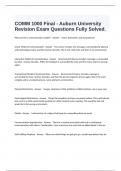COMM 1000 Final - Auburn University
Revision Exam Questions Fully Solved.
What are the 3 communication models? - Answer Linear, Interactive, and Transactional
Linear Model of Communication - Answer The source encodes, the message is surrounded by physical
and psychological noise, and the receiver decodes. This is not a full circle and there is no environment.
Interactive Model of Communication - Answer (Environment) Source encodes, message is surrounded
by noise, receiver decodes, THEN, the feedback is surrounded by noise and the source starts to encode
again.
Transactional Model of Communication - Answer (Environment) Source encodes, message is
surrounded by noise, receiver decodes, and then the process happens all over again. This is the most
complex and is a constant process. Same elements as interactive.
Physical Distractions - Answer Hunger, sleepiness, HVAC problems, bodily fucntions, sun in your eyes.
Psychological Distractions - Answer Things like prejudices and pre-conceived notions. This could also be
bias such as a white supremacist speaking at a black student union meeting. This would be bad and
would be in the wrong environment.
Phobia - Answer Irrational fear of a object that leads to a compelling desire to avoid.
Communication Apprehension - Answer The fear or anxiety associated with real or anticipated
communication with others. Comfortable v. how scared you are scale that we talked about in lecture.
Self Fulfilling Prophesy - Answer When you think things are going to go a certain way before they do.
,Physical Affects of Apprehension - Answer Rise in blood pressure, shortness of breath, galvanic
tightness of skin, sweat, speed of speaking increases.
Combatting Communication Apprehension - Answer Practice in front of a mirror, or others, do yoga,
visualize success, count to 5 really slowly, get a good night's sleep, don't be hungry; dialogue with your
audience, chat with your audience even before speaking.
Systematic Desensitization - Answer Where someone is slowly introduced to a fear so that their
sensitivity is decreased. Habitual desensitization.
What are the 3 ethics of public speaking? - Answer Ethics of choosing a topic, Ethics of research, Ethics
of language and delivery
What are the three types of plagiarism? - Answer Global (worst); Incremental=taking a few sentences
but not citing them; Patchwork Plagiarism (most common)=when you take a bunch of other people's
ideas and weave them together into one work that you claim-->this is also known as a failed attempt at
paraphrasing.
Ethics of Language and Delivery - Answer Maintain composure, describe people with respect and speak
in a gender neutral language (policeman=police officer/person), avoid profanity, balance simplicity and
complexity, balance emotion and language.
Ethics of Audience Members - Answer Keep an open mind, do not heckle (?), pay attention and watch
your nonverbal language, and do not talk!
Culture - Answer The distinctive ideas, customs, social behavior, products, or a way of life of a
particular nation, society, people, or period.
Hofstede's Cultural Dimensions=Example of Co Culture - Answer High vs. Low Power Distinction=CEO v.
Janitor; High vs. Low Uncertainty Avoidance=when you try to find out about a situation so you know
what to expect like asking questions about what is going to be on the final exam. Individualism vs.
Collectivism=being on your own vs. everyone that works together. The US is individualistic because we
are all fully autonomous. Masculinity vs. Feminism=females v. males; Long Term vs. Short Term
Orientation=the US is fast and productive whereas Spain has a daily siesta time. Indulgence vs.
Restraint=Indulgence stands for a society that allows relatively free gratification of basic and natural
, human drives related to enjoying life and having fun. Restraint stands for a society that suppresses
gratification of needs and regulates it by means of strict social norms.
Low Context Cultures v. High Context Cultures=Importance Placed on Verbal Cues - Answer High-
context cultures are those that communicate in ways that are implicit and rely heavily on context. In
contrast, low-context cultures rely on explicit verbal communication. High-context cultures are
collectivist, value interpersonal relationships, and have members that form stable, close relationships.
Co-Culture - Answer Groups that are impacted by a variety of smaller and different cultures.
Race and Ethnicity - Answer Race=a set of physical characteristics shared by a group of people, such as
skin color, body type, facial features, and hair color. Ethnicity=a group of people from (the same region?).
Sex=physical construction, Gender=social construction, Sexual Orientation=who you're romantically
attracted to.
Age Generation - Answer GI Generation=greatest generation that fought WWI. Silent Generation-came
into adulthood during the rise of the middle class. This was between WWI and WWII; Baby
Boomers=children of the GI generation, grew up with Woodstock and the Vietnam War; Generation
X=graduated from high school in the 80s and 90s. They were after the baby boomers. Millenials=some of
us, but not all. Mrs. Crider's Generation. Grew up differently, more hands on parents, a lot of these kids
go to college.
Communication, Diversity, and Dialoguge - Answer Dialogue-make the message accessible.
Dialogue - Answer Speaking in a way that encourages others to listen and listening in a way that
encourages others to speak.
Ethnocentric - Answer Believing your group's perspective is the only right one. Things like "How could
Jude POSSIBLY be an Alabama fan?!"
Make sure to avoid the "ist" language. This says you are judging people and want them to conform to
your way of doing one thing. - Answer Don't highlight differences in others. This demeans, ignores, and
inappropriately calls attention to or disrespects a particular culture or group.




